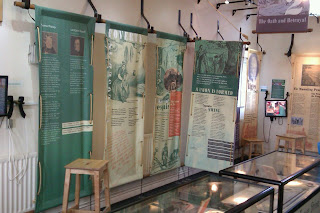One of our major reasons for choosing our present campsite,
 |
| Alexandro Farto mural in Exeter |
Huntisbeare, is its proximity to Exeter, a city that we both wanted to visit. Our first port of call was the
Park and Ride. We are definitely getting the hang of these and Exeter's is particularly good. My return fare was just £2.50 and Dave got a freebie with his bus pass. The seats were super comfortable too and it felt more like travelling on a coach than an everyday bus. There are several stops in the town centre and we jumped off near to a John Lewis on the High Street.
Also on the High Street, but several minutes walk away is a Whittards where I stocked up on our new favourite drink: Creme Brulee flavour White Hot Chocolate. It's basically pudding in a mug! I also bought a tub of Dreamtime Instant Tea which I used to drink in my A level days -a good twenty years ago (eeek!). Getting to sleep has been difficult for me recently - probably because I am getting up too late - so I impulse bought the Dreamtime Tea to see if it might help. Nearby, the superb mural pictured above was created by Portuguese artist
Alexandro Farto who drew the image onto the wall's plain render and then chipped it away to produce the striking monochrome effect. I haven't been able to find out who the woman is though. Someone local?
We tore ourselves away from the shops, but not before admiring the
 |
| Interesting architecture in Exeter |
architecture of some of the old buildings. The upper stories of Lakeland and its neighbour are particularly enchanting and I was disappointed that I couldn't get a good enough photo for you. The street is too narrow to step far enough back. Instead, these two great buildings, which really do sit so closely together, are near to the Cathedral. The red sandstone church on the left is St Martin's, one of the oldest churches in the city which was originally consecrated in 1065 and does still contain some Anglo Saxon stone from this time. There is an amazing variance in architectural styles and periods all around Exeter and especially in the Cathedral area. We saw a fantastic heavily carved wooden door that is about 500 years old and
the Exeter Memories website has interesting information about the rest of Cathedral Close.
We had picked up a
Visit Exeter booklet
while in Tavistock which
 |
| Bosses in Exeter Cathedral |
included a page of discount vouchers. One of these was a two-for-one entry into
Exeter Cathedral - a good deal and even more so when we were charged at Dave's concession price, not my standard adult! The Cathedral was very interesting and I loved the painted bosses in the vaulted ceiling. There are more than 400 and they are all carved with Gothic images including plants, animals and coats of arms. The lower of the larger bosses in this photo depicts the murder of St Thomas Beckett. The vaulted ceiling is the longest continuous medieval stone vault in the world and it is breathtakingly beautiful. Some of the tip-up seats in the choir stalls are also medieval and are beautifully carved with elephants, a whale, birds and plants. Tombs date from all periods so we saw representations of knights in full armour and in Elizabethan costume. I was fascinated by the astronomical clock, from 1484, which depicts both the moon and the sun in orbit around the earth. In a
a biography of Galileo
I have just read I learned about his imprisonment by the Catholic Church for suggesting that the earth was Not the centre of the universe and this clock perfectly illustrates the official Church beliefs of the period.
 |
| Astronomical clock in Exeter Cathedral |
Lunch was taken down on the Quayside which has been sympathetically
 |
| Exeter quayside |
restored and turned into a leisure area. We had a sharing plate of Chilli Nachos at a little cafe called
Mango's and just managed to escape an unexpected downpour by shifting tables to be under their huge umbrella. The coffee is good here. After eating, we took a wander along the arches which now house artisan and craft shops. One had a fantastic light designed by
Scott Nelmes. The river was quite busy with canoes and rowers and there were a lot of cyclists about too. We walked as far as the canal basin and I understand that there is a pretty flat cycleway,
the Exe Trail, from here to Exmouth and plans to continue it right around the Exe Estuary as far as Dawlish.
Back up the hill again, Dave mentioned visiting the
Exeter Phoenix, an
arts centre which is currently hosting a modern art exhibition,
The Exeter Contemporary Open. To be honest, much of the work was hit and miss for us although we did like
Mimei Thompson's oil paintings and
Henny Acloque's acrylic works. I was very taken with a video installation of pendula by
McGilvary White entitled Things That Swing. I think the sound effects are perfect! We also got to view a photographic exhibition of
Independents Of Exeter, photographed by
Vanessa Miles, which highlighted local small businesses and celebrated the inauguration of the
Exeter Pound - an initiative to keep local money spent locally.
After all that art and culture, we needed our reviving chai latte and chocolate milkshake at
Caffe Espresso which is a cute little place just opposite the castle - well worth the quick walk from the High Street to get there. We did then have some trouble finding the right stop for our bus back and were exhausted by the time we got back home.
 |
| Exeter's history in a single mural |








































